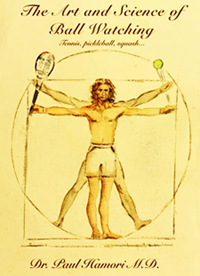The Bounce at 10,000 Frames
Per Second
Paul Hamori, MD
In my recent article on Tennisplayer.net about contact at 10,000 frames per second I found that contact is actually about 20% shorter than the generally published numbers. Additionally, I found that the trend toward low-tension stringing is probably aimed at increasing contact length which increases power and spin. (Click Here.)
So what about the ball bounce? What are the published figures? How long is the ball on the court surface? Again I set up controlled filming at 10,000 frames a second.
The generally accepted figure is 5 milliseconds as measured on a hard court. I found a range of 4.6-5.4 milliseconds. That is depending on whether the ball is topspin, flat, or slice.
Topspin is the shortest duration, flat is in the middle, slice is the longest. So the results are 92% to 108% of the published values. That's less variation than I found with the various durations of balls on the strings in the last article.
I think this is in generally agreement with what we perceive as players. When the ball is coming in with heavy topspin we know it's going to get on us quicker. When it is flat, or heavily sliced we know it's going to slide longer on the court and potentially be difficult to handle for that reason. But just as I found with strings, the difference between gut, nylon and poly are for all intents and purposes minimal.
Although I didn't have the opportunity to film all that, I think the numbers would differ depending on surface. Clay being softer, in all likelihood leads to a longer ball contact time than hard court. As an aside, in the earliest days of my tennis career–this goes back to 1969 --our only winter tennis option was a gymnasium at the University of my home town on wood.
That gives a whole new meaning to fast. It seemed the ball was sliding much longer on the wood before coming up.
Every shot was struck below the knees. Similarly, my experience on grass –in Palm Springs–clearly not the grass of Wimbledon–the ball also slides significantly longer, and slice is deadly--a good slice is often unreturnable.
I used to take a hitting lesson with a former world-class professional. He always used to tell me, "Paul, never give a pro a mid-court slice. That point is going to be over." A corollary to this however, is always give a club player a mid-court slice, you probably have a greater than 50% chance of winning the point.
Physics
So let's delve into the physics of the bounce. The following scientific descriptions are taken from Drs. Howard Brody and Rod Cross and their seminal works, The Physics and Technology of Tennis (Click Here), and Technical Tennis (Click Here.) Both are must reads for the tennis technology enthusiast.
They may have too much information for many players, but I think there are important lessons to be learned. As I often tell patients in my medical practice, knowledge is power–the power to decide what to do.
7 Phases
The bounce consists of the following phases: touchdown, slowing/squashing, spinning, sliding, biting, stretching, then liftoff. All of this happens in roughly 5 milliseconds. To quote Rod Cross, "the innocent looking computer generated skid marks of shot spot are the forensic remnants of an incredible sequence of happenings that, until now, you simply thought of as in or out."
Three kinds friction affect the ball bounce: sliding friction, rolling friction, and static friction. To quote Dr. Rod Cross again, "Sliding friction acts on the ball while it is sliding on the court. Rolling friction is a weaker force that acts when the ball is rolling on the court.


"Static friction acts on an object when it is at rest on the surface. Static friction allows the ball to grip or bite a surface–similar to a shoe or ball if were stuck down with sticky tape. Static friction acts to stop the contact surfaces sliding past each other providing the surfaces are pushed firmly together. Static friction plays a role in the bounce of the ball but sliding friction plays a much more important role in changing speed and spin of the ball."
Cross describes 4 bounce factors: Angle of incidence, speed/spin, hardness of the court, smoothness/roughness of court. These factors subsequently affect how long the ball is down on the court, how fast it comes off the court, how high it bounces, and what kind of spin it comes off the court with.
Everyone who took high school physics can probably tell you "the angle of incidence is equal to the angle of reflection in a perfectly elastic collision". Simply put this means the ball comes off of the court at about the same angle it goes into the court.
In real life there is no such thing as a perfectly elastic collision. In a tennis bounce energy is lost with ball compression and court compression, and then friction and spin play their role to change things as well. In an elastic collision speed would not be changed, but the tennis ball bounces leads to a 25-40% reduction in ball velocity.
John Yandell was the first to document this in actual match play in his study of ball flights by Pete Sampras about 20 years ago. (Click Here.)
Tennis balls lose about 20% of their flight speed while traveling through the air and then go on to lose another 25-40% after the bounce.
Because of the effect of the bounce, the net result is that the ball bounces up about three quarters of its vertical drop. Excepting serves and overheads, it is simply the vertical drop of the ball from the maximum height of ball trajectory that determines how high the ball bounces.
Higher Bounce
Which bounces higher? Topspin or slice? This is a paradox–a seeming contradiction that is nevertheless true. Everyone will tell you topspin bounces higher–that is our practical experience.
But for a given angle of incidence, slice bounces higher. However slice always comes in at a lower angle–hence our perception that it is lower bouncing. Topspin is typically coming from a higher peak, and dropping at a steeper angle, which adds to the higher bounce.
Hardness of the court is an obvious factor in how high the ball will bounce. As in my previous example above, wood bounces extremely low, grass–particularly traditional grass- bounces low, carpet bounces low, hard courts bounce higher, and clay courts bounce the highest.
Rod Cross states the following: "For a flat ball coming in a 15° angle, it comes off grass court at 16°, a hard court at 18°, and clay at 21°. Hence a 5% difference between the fastest courts–grass and the slowest courts–clay. I would estimate that wood courts are at about 12% angle.
Court smoothness or roughness affects the friction, which subsequently affects horizontal ground speed, bounce height, and spin change. As would be expected, for length of time on the ground, topspin loses less speed, flat is in the middle, and slice loses the most speed.
Topspin balls come off the ground retaining topspin, flat balls come off the ground with topspin rotation as do most slices.
Biting
Biting is a term used to describe the ball transiently stopping on the court surface. The bottom of the ball that has a transient stop while the top of the ball continues with rotation and forward speed.
Topspin bites sooner than back spin and flat shots which slide more prior to biting. The spin after the bounce is primarily a factor of how fast the top of the ball is moving relative to the bottom of the ball at the time of biting or the bottom of the ball stopping.
Thus topspin balls come off with continued significant topspin. In fact in pro tennis often with more topspin than was originally created by the racket. In his study of ball bounces at the U.S.Open in 1997, John Yandell found that after the bounce balls hit with topspin actually had about 2000rpms greater than before the bounce (Click here).
Flat balls come off with some topspin. Slice balls are variable depending on slice rotation speed coming into the bounce. Typically they come off with a slight topspin rotation, although they also can come off flat.
Here are the averaged numbers from my experiments.
Topspin balls had 1785rpm coming into the bounce and 2725rpm coming out. The flat balls were basically zero rpm coming into the bounce and 2175rpm coming out. The slice balls had 1575rpm of underspin coming into the bounce and had 1485rpms of topspin coming out.
A rule of thumb supplied by Dr. Cross is "balls that hit the court at less than 20° tend to slide through the bounce and sliding friction will determine how the ball bounces. Balls that hit the court at greater than 20° tend to bite more and come up at age steeper angle."
So What?
How if at all does this apply to your daily tennis? Primarily, since the brain is a prediction engine you can use it to predict the bounce.
You have many clues. This starts with the sound of the ball off of your opponent's racket, then trajectory, angle of incidence, and observed spin. From all this you can start to anticipate what kind of bounce you're going to get and where you are going to need to position your body in order to take the ball at a comfortable level.
Topspin balls come in steeper, bite sooner, and bounce higher. Flat balls slide more, come off with slight topspin, and loose less speed than slice. Slice balls come in lower, slide significantly longer and slow significantly more leading to some potential timing issues. You commonly see even pros missing a sliced ball after a long series of topspin balls prior to the slice.
Teaching pros the world over are fond of a drill first developed by Timothy Gallwey called "bounce– hit." It's a way of focusing the mind on the ball at the most important time–during the bounce and just prior to contact.
In order to do this drill simply say to yourself in your mind (or out loud if it's not a competitive match) "bounce" when the ball bounces and "hit" as you hear the contact. This is an amazing drill that can dial in your strokes for timing and consistency.
One last point in closing: I pose a rhetorical question: The ball is on the ground between 4.6 and 5.4 milliseconds. Can you see it bounce? The answer has to be yes or you have been making some pretty bad line calls. How can the brain process such a short time interval? In a future article I will reveal the answer.





